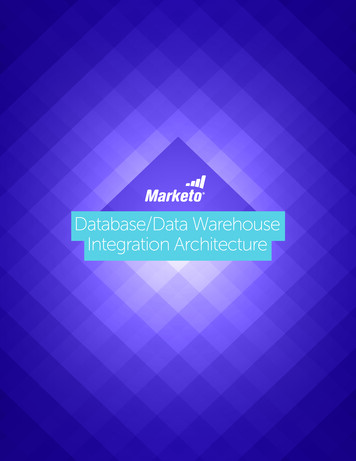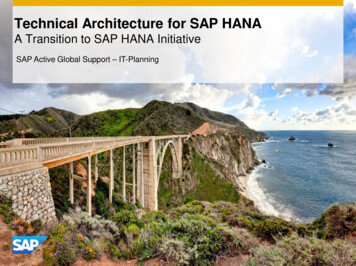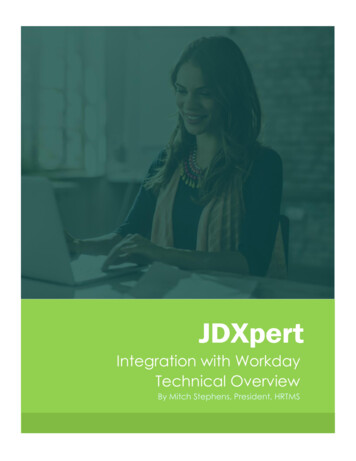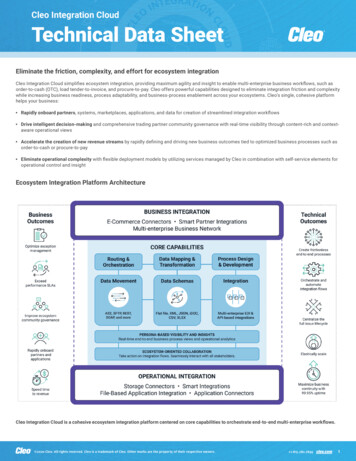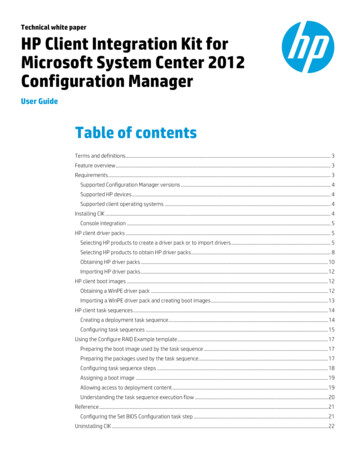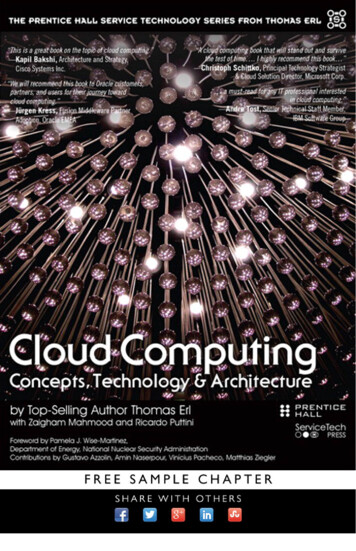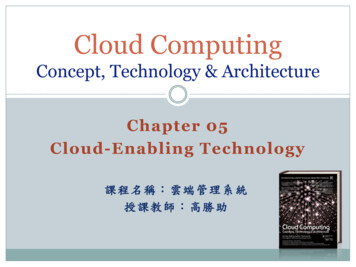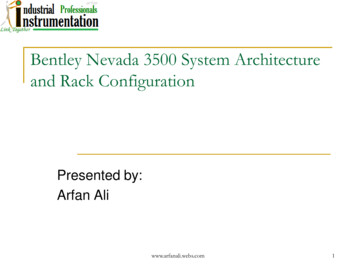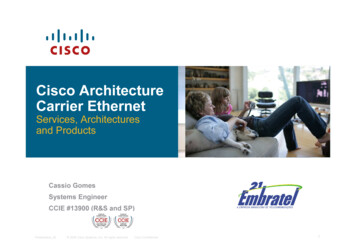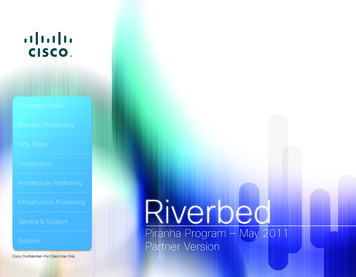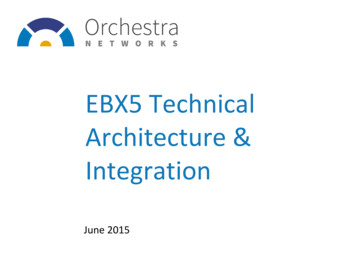
Transcription
EBX5 TechnicalArchitecture &IntegrationJune 2015
Architecture overviewWS ClientJava Application ServerRDBMSClient 100% Browser-based (HTTP/HTTPS) Supported browsers: IE, Firefox, Chrome, Safari Web Services client: SOAP over HTTP/HTTPS or JMSServer Servlet container in JRE 1.5 (Servlet 2.4) Example: IBM WebSphere, Oracle WebLogic,Apache Tomcat, RedHat JBoss Deployment: EAR or WAR/JARDatabase Oracle Database 10gR2 or higher PostgreSQL 8.4 or higher Microsoft SQL Server 2008 or higher IBM DB2 UDB v8.2 or higher H2 v1.3.170 or higher (dev)
Hardware / Service Components
Logical Architecture
Interfaces & Deployment
InterfacesData ServicesWeb Services (SOAP/WSDL)generated from data modelsEBX5FilesRDMBSSQLFile import/export in XML, CSV,XLS, XLSXNative SQL access
Data ServicesWeb Services (SOAP/WSDL) dynamically generated from data models. Over HTTP/S or JMSProduct Data Model(XML Schema doc)ProductProduct-IDNameFamilyPricing 0 - PriceDiscountProduct Data Service(WSDL)Operationsselect Productinsert Productupdate Productdelete ProductDynamicallygenerated DataServices from aData Modelcount ProductgetChanges ProductMDM Features DataService (WSDL)Note: rich types (heremulti-value complex type)supported in both datamodel and data servicesOperationscreate DataSpacecreate Snapshotclose DataSpaceclose Snapshotmerge DataSpacevalidate DataSetvalidate DataSpacestart workflowend workflowPrebuilt DataServices on MDMfeatures
Data ServicesObjectives Provide a standards-based service layer on MDM Expose all operations as a serviceo CRUD on data setso MDM features (workflow, version control.) Decouple MDM from applicationsHow it works Dynamic generation of Web Services from the data model WSDL mapped on XML Schema data model (same standard) Absorbs data model changes on the flyo No code generation requiredo No redeployment cycle requiredKey features CRUD web service on any Data Set (based on Data Model)o Insert / Update work on both bulk and per record modes MDM features on Data Spaces, Workflow. Security: HTTP Authentication or WSSE SOAP-fault for validation errors
Data Propagationo EBX provides a canonical format in XML, XLS or CSV (the one created during the datamodel design time)o A middleware (e.g ODI) is in charge to transform this format to a suitable format forthe target system and integrate the transformed data using a dedicated connector.EBXFiles(XML/XLS/CSV)Java APIRDBMSSQLMiddleware (ETL, ESB)Web sETLESBAutre (DQ, BPM, BRMS)Informatica PowercenterIBM DatastageOracle ODITalend ETLMicrosoft SSIWebMethods ESBJBoss ESBOracle OSBTibco ESBIBM ESBIBM MQMicrosoft BizTalkIBM Quality StageTibco BusinessWorksWebMethods BPMOracle BPMIBM JRulesInformatica Data QualityMS SharePointMS Excel
Data PropagationSynchronous/Asynchronous mode: EBX provides both modes Best practice for real time is to sync at merge time Batchs can be triggered using any third party software or using the natively providedschedulerDelta/Full propagation: EBX enables delta and full stock mechanisms, down to attribute level Delta is easily identified using dataspaces Native web service to get delta between dataspaces/versions
Data PropagationTarget systems/environments: EBX provides native export/import archive mechanism in order to propagate databetween environments (also applies to data model, workflow models, configurations,etc). Leverages dataspace native merging mechanism to put together data from bothsource and target systems. Can be automated using native scheduler (or third party tool), or in sync withdataspace merge event.
SQL Interfaces for data accessRDBMSDataHistoryInsightUsing SQL Connect,Master Data areautomatically replicated innative SQL tablesRecord level history isstored in native SQL tablesData Quality indicatorsgenerate historical data innative SQL tables
Deployment architecturesMultiple deployment options can be combinedActive/PassiveFailoverEBX(Active)DB clusteringEBX clustering(using D3)EBXEBXDB clusterRDBMSEBX(Passive)RDBMSRDBMSRDBMSSync using D3Pool of EBXEBXEBXRDBMSRDBMS
Integration scenarioExamples
Example: Authoring and export via an ETLInsert a newrecordMerge DataSpaceExport updateMain Data SpaceUpdateTransform andexport
Example: Authoring and export via an ESBInsert a newrecordMerge DataSpaceNotifymiddlewareMain Data SpaceUpdateGet changes orselectPush updatesto apps
Example: xRef look-up in an integration processMain Data SpaceIntegrationprocessTransformLook-up xRefPush updatesto apps
Example: Import data in staging areasMerge DataSpaceMerge DataSpaceMain Data SpaceStaging 1Staging 2Import datafrom App 1Import datafrom App 2
Example: Launch approval workflowApprove inworkflowMain Data SpaceStart WorkflowUpdateImport datafrom AppLaunchapprovalworkflowMerge DataSpace
D3: Distributed DataDelivery
Distributed architectureMaster EBXData Governance TimeSlave EBXData Consumption TimeEBXD3 SlaveEBXEBXD3 MasterD3 SlaveEBXD3 SlaveMaster EBXData Governance Time1EBXSlave EBXData Consumption Time23EBX4D3 Master56D3 SlaveD3 Master Defines a data space as deliverable Associates it to delivery profiles Control & monitor profiles subscribers Broadcasts data updates 2-phase commitD3 Slaves Automatic registering Receive updates Commit changes Read-only on synchronized data spaces Write on local data spaces1. Data is updated in EBX (via UI or Services)2. Update is pushed to D3 Slaves3. Update is received by D3 Slaves4. Acknowledgment by D3 Slaves to D3 Master5. D3 Master sends commit instruction to D3 Slaves6. Update is committed to EBX SlavesMessages: SOAP on HTTP/HTTPS, Data updates on TCP-IP
Example: Geographical FederationMasterMDMEU ClusterSlave 1Slave 2NA ClusterAPAC ClusterSlave 5Slave 6Slave 3Slave 4
Example: Realtime Data ClusterRead-only accessUpdateLoad BalancerEBX MasterApp ServerSOAP HTTP SynchronisationSOAP HTTPJVMEBXData Spaces BroadcastEBX Slave 1EBX Slave 2App ServerApp ServerJVMJVMEBXEBXRDBMSRDBMSTCP/IP SocketRDBMS
Managing master data at different levelsProduct data ismanaged centrally inthe master MDMinstanceMasterMDMSlave MDMProduct DataProduct DataLocal SuppliersProduct data issynchronized to theslave MDM instanceLocal suppliers aremanaged in the slaveMDM instance andlinked to globalproducts
Integration with EnterpriseSecurity Systems
Custom Authentication Requiremento Enterprise directory (for instance LDAP, Active Directory) responsiblefor holding the users' authentication information (login/password). Passwords are not stored in EBX5. Whenever opening a session (log on through the GUI, SOAP request oraccess through the Java API), authentication is performed against theenterprise directory. Implementationo Users declared in EBX5 directory only with their login (no password),to be able to assign them roles.o Develop a custom Java class (using EBX5 API) responsible fordelegating the authentication to the enterprise directory (usuallyusing the LDAP protocol).
Fully externalized users and roles Requirement (in addition to the "custom authentication" use case)o User - role associations declared and maintained in the enterprise directory. Implementationo EBX5 directory not used.o Authentication delegated to the enterprise directory.o Custom Java component responsible for retrieving the user's roles from the enterprise directorywhenever needed by EBX5 (in order to avoid overloading the directory, this component wouldtypically maintain a cache of users and roles with an appropriate synchronization policy).ActiveDirectoryCustom JavacomponentLDAPUsers and roles cacheHTTPAuthenticationUsersCore featuresRolesPermissionsevaluationengineEBX5
Custom internal directory in EBX5 Requiremento Periodic password expiration.o Account locking when typing a wrong password three times in a row.o Specific pattern for passwords : Eight characters length. Must contain letters and digits. Implementationo EBX5 built-in directory not used.o Custom directory inside EBX, as a data set in a dedicated Data Space Based on a custom schema (built-in directory's schema can be re-used andenriched). Specific rules (password expiration account locking) in a custom Java classoverriding built-in authentication.o Define role-based permissions on these Data Space and data set: Only authorized users (directory's administrators) can access and update it. The Data Space hosting the directory is hidden for business users.
Single sign-on (1/2)EBX5 can be integrated into a SSO context, in order to share userauthentication with other applications (Once authenticated, the user canaccess any application part of the SSO context).EBX5 is compatible with the different kinds of SSO Systems: NTLM (Integrated Windows authentication) Kerberos IBM Tivoli Directory Server Lightweight Third Party Authentication (IBM WebSphere) Central Authentication Service (CAS)
Single sign-on (2/2)EBX5 does not handle authentication anymore.Override the built-in authentication mechanism. Implementation will depend on the target SSOSystem (EBX5 API gives access to the HTTP request, this is useful for ticket-based SSO Systems). When a user without any active EBX5 session tries to access the GUI :o Check if the user is already authenticated in the SSO context.o If not, redirect him to the SSO authentication page.o If yes, open an EBX5 session for this user and redirect him to the GUI home page. EBX5 GUI login policy can be customized if necessaryo Configuration done in the deployment descriptor of ebx.war (web.xml).o Choose the appropriate authentication method (Basic, Digest or Form-based, as described in Servlet2.3 specification). W hen using Form-based authentication method : Customize the default login page in orderto submit login/password to the SSO authentication system.
Thank facebook.com/OrchestraNetworks
Example: IBM WebSphere, Oracle WebLogic, Apache Tomcat, RedHat JBoss Deployment: EAR or WAR/JAR Database Oracle Database 10gR2 or higher PostgreSQL 8.4 or higher Microsoft SQL Server 2008 or higher IBM

